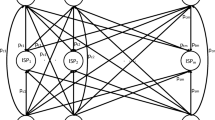Abstract
With the advent of 4G LTE networks, the demand for bandwidth has rapidly increased among users of mobile devices, especially handheld smartphones. Consequently, the 4G data plans offered by mobile network operators have become expensive in many countries around the world. Moreover, due to the discrete tiers of the data plans, users often experience shortage or surplus. In order to facilitate sharing of bandwidth among users, we propose a game theoretic framework where users share bandwidth with each other. The sharing mechanism is based on the distribution of surplus bandwidth of some users to overcome the shortage of others. All users sometimes serve as providers (i.e., offering bandwidth to others) and sometimes as receivers (i.e., receiving bandwidth from the providers), thus constituting a user-provided network (UPN). The sharing game is designed in such a way that those receiving bandwidth are obligated to offer the same to others at a later point of time. Unused bandwidth of a user is shared to other users who require bandwidth at that instance, who must return the bandwidth that they use to the provider of the bandwidth at a later time based on requirement, by a coordination-based model of user interaction in the UPN that consists of these entities. Further, we have developed a coordination-based game model to better simulate user interaction in this context. In order to validate the proposed framework, we conducted simulations experiments as well as conducted experiments with handheld devices where bandwidth from a 4G LTE commercial network provider was shared among the devices. Results reveal that a Nash Equilibrium is reached for the overall set of interactions between users sharing and receiving bandwidth, provided that a Nash Equilibrium is reached in the interactions between each pair of users.




















Similar content being viewed by others
References
livemint.com (2017) How much are you spending on mobile data. http://www.livemint.com/Money/xWFJ353DGq1WZOceuXPSrO/How-much-are-you-spending-on-mobile-data.html
nokia.com. NOKIA : Nokia MBiT Index reports 4G contributed to 92% of total data traffic in 2018 in India. https://www.nokia.com/about-us/news/releases/2019/02/21/nokia-nokia-mbit-index-reports-4g-contributed-to-92-of-total-data-traffic-in-2018-in-india/
Alliance for Affordable Internet (2017) A4AI 2017 Affordability report. Alliance for Affordable Internet
Alliance for Affordable Internet (2018) A4AI 2018 Affordability report. Alliance for Affordable Internet,
developer.att.com (2012) Comparing LTE and 3G energy consumption. https://developer.att.com/application-resource-optimizer/docs/best-practices/comparing-lte-and-3g-energy-consumption
Nisan N, Roughgarden T, Tardos E, Vazirani VV (2007) Algorithmic game theory. Cambridge University Press, Cambridge, p 7
Dutta Prajit K (1999) Strategies and games: theory and practice, 2nd edn. MIT Press, New York, p 38
Golle P, Leyton-Brown K, Mironov I (2001) Incentives for sharing in peer-to-peer networks. In: 3rd ACM conference on electronic commerce, pp 264–267
Santos A, Anta AF, Cuesta JA, Fernández LL (2016) Fair linking mechanisms for resource allocation with correlated player types. Springer Comput 98(8):777–801
Sun Y, Yan J, Ding W, Gao X, Li J, Ding Z (2008) A bandwidth resource allocation method for next generation network based on cooperative game. In: 4th International conference on wireless communications, networking and mobile computing, pp 1–4
Hew SL, White LB (2008) Cooperative resource allocation games in shared networks: symmetric and asymmetric fair bargaining models. IEEE Trans Wirel Commun 7(11):4166–4175
Zhang H, Niyato D, Song L, Jiang T, Han Z (2016) Zero-determinant strategy for resource sharing in wireless cooperations. IEEE Trans Wirel Commun 15(3):2179–2192
Shen H, Li Z (2016) New bandwidth sharing and pricing policies to achieve a win–win situation for cloud provider and tenants. IEEE Trans Parallel Distrib Syst 27(9):2682–2697
Oo TZ, Tran NH, Saad W, Niyato D, Han Z, Hong CS (2017) Offloading in HetNet: a coordination of interference mitigation, user association, and resource allocation. IEEE Trans Mobile Comput 16(8):2276–2291
Vo Phuong L, Tran Nguyen H (2019) Cooperative caching for HTTP-based adaptive streaming contents in cache-enabled radio access networks. Springer Comput 101(5):435–453
Pyattaev A, Johnsson K, Andreev S, Koucheryavy Y (2013) Proximity-based data offloading via network assisted device-to-device communications. In: IEEE 77th vehicular technology conference (VTC Spring), 2013, pp 1–5
Al-habob AA, Shnaiwer Y, Sorour S, Aboutorab N, Sadeghi P (2018) Multi-client file download time reduction from cloud/fog storage servers. IEEE Transa Mobile Comput 99:1924–1937
Iosifidis G, Gao L, Huang J, Tassiulas L (2017) Efficient and fair collaborative mobile internet access. IEEE ACM Trans Netw 25(3):1386–1400
Chen Y, He S, Hou F, Shi Z, Chen J (2017) Promoting device-to-device communication in cellular networks by contract-based incentive mechanisms. IEEE Netw 31(3):14–20
Li Y, Jin D, Yuan J, Han Z (2014) Coalitional games for resource allocation in the device-to-device uplink underlaying cellular networks. IEEE Trans Wirel Commun 13(7):3965–3977
Gu Y, Zhang Y, Pan M, Han Z (2015) Matching and cheating in device to device communications underlying cellular networks. IEEE J Sel Areas Commun 33(10):2156–2166
Fu B, Wei Z, Yan X, Zhang K, Feng Z, Zhang Q (2015) A game-theoretic approach for bandwidth allocation and pricing in heterogeneous wireless networks. In: IEEE wireless communications and networking conference (WCNC), 2015, pp 1684–1689
Vlachos C, Friderikos V (2015) Optimal virtualized resource slicing for device-to-device communications. In: 2015 IEEE global communications conference (GLOBECOM), San Diego, pp 1–7
Eslami Rasekh M, Guo D, Madhow U (2020) Joint routing and resource allocation for millimeter wave picocellular backhaul. IEEE Trans Wirel Commun 19(2):783–794
Promponas P, Apostolopoulos PA, Eleni Tsiropoulou E, Papavassiliou S (2019) Redesigning resource management in wireless networks based on games in satisfaction form. In: 2019 12th IFIP wireless and mobile networking conference (WMNC), Paris, France, 2019, pp 24–31
Author information
Authors and Affiliations
Corresponding author
Additional information
Publisher's Note
Springer Nature remains neutral with regard to jurisdictional claims in published maps and institutional affiliations.
Supplementary Information
Below is the link to the electronic supplementary material.
Rights and permissions
About this article
Cite this article
Sanyal, J., Samanta, T. & Chatterjee, M. Game theoretic approach for bandwidth sharing in future generation networks. Computing 103, 613–640 (2021). https://doi.org/10.1007/s00607-020-00872-z
Received:
Accepted:
Published:
Issue Date:
DOI: https://doi.org/10.1007/s00607-020-00872-z




